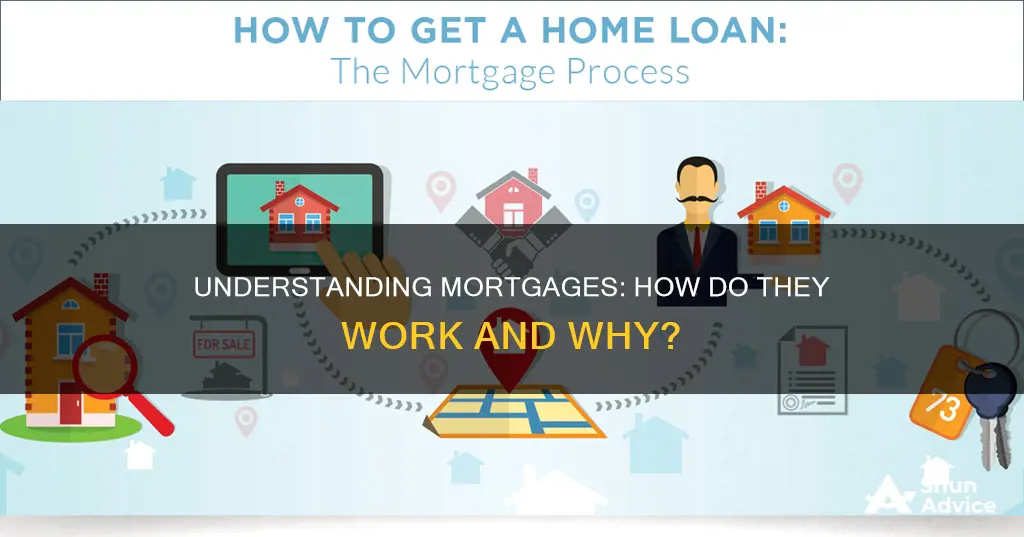
Mortgages are loans used to purchase or maintain real estate, including homes, plots of land, or commercial properties. They are essential for buyers who cannot afford to buy a property outright with cash. The borrower agrees to pay the lender over time, typically in a series of regular payments, and the property serves as collateral to secure the loan. The monthly payments include principal, interest, and any required mortgage insurance, and may also include property tax and homeowners insurance. The interest rate on a mortgage is based on macroeconomic factors and the borrower's credit history and financial fitness. To qualify for a mortgage, borrowers must meet certain eligibility requirements, including a steady income source, a low debt-to-income ratio, and a decent credit score.
| Characteristics | Values |
|---|---|
| Definition | A loan used to purchase or maintain real estate, including houses and commercial properties. |
| Who is it for? | Borrowers who cannot afford to buy a property outright. |
| Types | Conventional mortgages, government-backed mortgages, jumbo loans, Veterans Affairs (VA) loans, Federal Housing Administration (FHA) loans, Family Opportunity Mortgage, etc. |
| Requirements | Steady income source, debt-to-income ratio lower than 50%, minimum credit score of 580, down payment (usually 20% but can be lower), good credit history, financial fitness. |
| Application Process | Rigorous underwriting process, submission of additional documents (tax forms, pay stubs, bank statements, etc.), loan processing. |
| Costs | Down payment, interest rate, property taxes, insurance (hazard, homeowners, mortgage), escrow account, closing costs (origination fees, discount points, underwriting fees, processing fees, document preparation fees, funding fees), refinancing costs. |
| Duration | Typically 30 years. |
| Payment | Monthly payments comprising principal, interest, taxes, and insurance (PITI). |
| Lenders | Banks and other financial institutions. |
What You'll Learn

What is a mortgage?
A mortgage is a loan used to purchase or maintain real estate, including houses and commercial properties. Mortgages are an essential part of home buying for borrowers who cannot afford to buy a property outright. The money borrowed from the bank needs to be repaid with interest, and in exchange, the borrower gets to occupy the home and renovate it as they wish.
Mortgages are typically paid back over 30 years, with monthly payments. These payments are split into at least four buckets: principal, interest, taxes and insurance (PITI). The principal is the portion of the loan balance that is paid down with each payment. Interest is the percentage charged monthly by the lender for the mortgage. Taxes are paid 1/12th of the yearly property tax bill each month, based on the assessment for the year in the neighbourhood. Insurance covers the home against hazards like fire, theft or accidents. In the early years of a mortgage, interest makes up a greater part of the overall payment, but over time, the borrower starts paying more principal than interest until the loan is paid off.
Before applying for a mortgage, it is important to check your credit score and credit report, as mortgage lenders will be checking these to determine the interest rate. The higher the credit score, the lower the interest rate will be, which means monthly mortgage payments will be lower. It is also important to compare rates and fees from different lenders to get the best deal.
There are different types of mortgages available, including conventional mortgages, government-backed mortgages and jumbo loans. Conventional mortgages are the most common option, often requiring a down payment of only 3%. Jumbo loans are for those who need to borrow more than the conforming loan limit, which in 2023 was $726,200.
Understanding Mortgage and Title Search: What You Need to Know
You may want to see also

How to get a mortgage
Getting a mortgage is a big step, and it can be a long process. Here is a step-by-step guide on how to get a mortgage:
Step 1: Prepare Financially
First, you need to ensure you are financially prepared for homeownership. Understand your income, debts, and savings to know how much you can afford to borrow. Lenders will also look at your credit score when determining your eligibility for a mortgage, so it is important to have a good credit score. A score of at least 620 will qualify for most loan types, but a higher score is preferable.
Step 2: Get Pre-Approved
Getting pre-approved for a mortgage has several advantages. It shows sellers that you can make a solid offer, and it helps you understand the true cost of your mortgage, including the rate, APR, fees, and closing costs. It is recommended to get pre-approved by at least three lenders and compare rates to get the best deal.
Step 3: Choose a Lender and Loan Officer
You can choose a local lender or search for the best deal online. It is worth asking friends and family for recommendations and researching individual loan officers to find someone experienced and knowledgeable. Avoid places that assign loan officers, as the quality of service can vary.
Step 4: Complete the Application
You can usually apply for a mortgage in person, by phone, or online. The application will require detailed information about your finances, including income, debts, and assets. You will also need to provide documentation to verify your employment history and financial situation. Be sure to complete the application accurately and disclose all relevant information to avoid delays in the process.
Step 5: Lock in Your Rate
Since interest rates fluctuate, you may want to lock in your rate with your lender when you apply for your loan. This guarantees the interest rate and discount points until the rate lock expiration date. However, locking in your rate is a personal choice, and you may choose to wait if you believe interest rates will decrease in the future.
Step 6: Understand the Costs
Your monthly mortgage payment will typically include principal and interest, as well as homeowners' insurance and property taxes. Depending on your down payment and loan type, you may also need to pay private mortgage insurance. There may also be additional fees and closing costs associated with the loan.
Step 7: Explore Assistance Programs
If you are a first-time homebuyer or eligible under other criteria, you may qualify for government-backed mortgage assistance programs or specific loan types, such as FHA loans, VA loans, or energy-efficient mortgages (EEMs). These programs can help with lower down payments, closing costs, or purchasing energy-efficient homes.
Remember, the process of getting a mortgage can be complex and time-consuming, but with careful planning and research, you can navigate it successfully.
Mortgage Paperwork: What to Expect and How to Prepare
You may want to see also

Mortgage types
A mortgage is a loan used to purchase or maintain real estate, including houses and commercial properties. Mortgages are typically paid back to the bank in a series of regular payments over 30 years. The property serves as collateral to secure the loan. There are several types of mortgages available, each designed for different financial situations. Here are some of the most common types:
Conventional Loans
These are the most popular type of mortgage and are offered by private banks. They can be further divided into two types: conforming and non-conforming loans. Conforming loans meet a set of Federal Housing Finance Agency (FHFA) standards, including guidelines on credit, debt and loan size. They are eligible to be purchased by government-sponsored enterprises (GSEs) such as Fannie Mae and Freddie Mac. Non-conforming loans, on the other hand, do not meet one or more of these standards and are considered riskier for lenders. A common type of non-conforming loan is a jumbo loan, which exceeds the conforming loan limit and is used to finance more expensive properties.
Government-Backed Loans
These loans are insured by different federal agencies and are designed to make homeownership more accessible. They often have more favourable requirements, fees, and terms. For example, the Federal Housing Administration (FHA) offers loans with a credit score requirement as low as 500 and a down payment of 3.5%. The U.S. Department of Veterans Affairs (VA) guarantees loans for eligible members of the military, veterans, and their spouses.
Fixed-Rate Loans
With this type of mortgage, the interest rate is set for the life of the loan, usually 15 or 30 years. This provides more certainty and stable monthly payments, making it a good option for those who value predictability in their loan costs.
Adjustable-Rate Loans
Also known as ARMs, these loans offer a variable interest rate that can go up or down based on market changes. They provide less predictability but could be cheaper in the short term. This type of mortgage may be suitable for those who plan to move within the initial fixed-rate period or are comfortable with potential rate adjustments.
Researching Mortgage Records: Palm Beach County Guide
You may want to see also

Monthly payments
Monthly mortgage payments are typically due on the first of every month. However, unlike rent payments, you pay in arrears, meaning you pay for the previous month. For example, if you closed on your house on the 19th of January, your first mortgage payment would be due on the 1st of February.
The amount you borrow with your mortgage is called the principal or the mortgage balance. Each month, part of your monthly payment goes towards paying off the principal, and part pays interest on the loan. Interest is what the lender charges you for lending you money. In the beginning, you owe more interest because your loan balance is still high. As you pay down the principal, you owe less interest each month, and more of your monthly payment goes towards paying down the principal. This process is known as amortization.
The main factors determining your monthly mortgage payments are the size and term of the loan. The size is the amount of money you borrow, and the term is the length of time you have to pay it back. Generally, the longer the term, the lower the monthly payment. That's why 30-year mortgages are the most popular.
Most people's monthly payments also include additional amounts for taxes and insurance. Property taxes are usually paid annually, but homeowners typically pay them in monthly instalments as part of their mortgage payments. The government requires these taxes to fund public services like schools, fire and police departments, and public works departments. Insurance payments work similarly to property tax payments. You'll include them as part of your monthly mortgage payment even though they're due only once a year. Your lender will hold the insurance money in escrow for you and pay it when it's due.
If you make a down payment of less than 20%, you will be required to take out private mortgage insurance, which increases your monthly payment. A good gauge to tell if you can afford a mortgage is if the monthly payments are no more than 25% of your monthly take-home pay.
Cosigning a Mortgage: Benefits and Risks for All Involved
You may want to see also

Interest rates
Market conditions, such as inflation, changes in the housing market, and monetary policies, also impact interest rates. During economic downturns, interest rates tend to decrease to encourage borrowing and spending. Conversely, periods of job growth and economic recovery correspond to higher interest rates. Additionally, lenders adjust interest rates based on their assessment of the loan's riskiness. Riskier loans, determined by factors like the likelihood of repayment and potential losses in case of default, carry higher interest rates.
The type of loan, whether fixed-rate or adjustable-rate, also affects the interest rate. With a fixed-rate mortgage, the interest rate remains unchanged for the loan's duration, providing stable and predictable monthly payments. Adjustable-rate mortgages, on the other hand, offer a lower starting rate but can climb higher over time, depending on market fluctuations.
It is important to note that even small differences in interest rates can significantly impact the total cost of the loan. Therefore, borrowers should carefully consider their options and seek competitive rates from multiple lenders. Additionally, strategies such as improving one's credit score, choosing shorter loan terms, and utilising discount points can help secure more favourable interest rates.
Mortgage Brokers: Verifying License Numbers and Legitimacy
You may want to see also
Frequently asked questions
A mortgage is a loan used to purchase or maintain a home, plot of land, or other real estate. The borrower agrees to pay the lender over time, typically in a series of regular payments. The property then serves as collateral to secure the loan.
First, you will need to check your credit score and prepare the necessary documents. Then, you will need to apply for a mortgage through your preferred lender and ensure that you meet the requirements, including minimum credit scores and down payments. After your application is approved, you will need to compare offers from different lenders and choose the one that suits you best. Finally, you will need to go through the loan processing stage, where the lender will review your application and verify the information you provided.
There are several types of mortgages available, including conventional mortgages, government-backed loans, fixed-rate mortgages, and adjustable-rate mortgages. Conventional mortgages are the most common option, often requiring a small down payment. Government-backed loans, such as Federal Housing Administration (FHA) loans, allow buyers to have a higher debt-to-income ratio. Fixed-rate mortgages have a fixed interest rate, while adjustable-rate mortgages have a variable interest rate that can change over time.
A WORM (Write-Once-Read-Many) memory card is a non-erasable and non-rewritable storage solution that ensures the safekeeping of crucial mortgage data. It prevents unauthorized access to files, making it ideal for storing key documents associated with mortgage loans.
A monthly mortgage payment typically includes principal, interest, taxes, and insurance (PITI). The principal is the portion of the loan balance that is paid down with each payment. The interest is the monthly interest rate charged by the lender. Taxes refer to the yearly property tax bill, which is typically paid in 12 installments each month. Insurance includes homeowners insurance and, in some cases, separate mortgage insurance.







